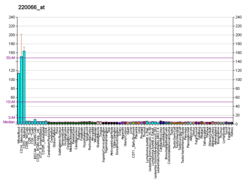Nucleotide-binding oligomerization domain-containing protein 2 (NOD2), also known as caspase recruitment domain-containing protein 15 (CARD15) or inflammatory bowel disease protein 1 (IBD1), is a protein that in humans is encoded by the NOD2 gene located on chromosome 16.[5][6] NOD2 plays an important role in the immune system. It recognizes bacterial molecules (peptidoglycans) and stimulates an immune reaction.[7]
NOD2 is an intracellular pattern recognition receptor, which is similar in structure to resistant proteins of plants and recognizes molecules containing the specific structure called muramyl dipeptide (MDP) that is found in certain bacteria.[8]
- ^ a b c GRCh38: Ensembl release 89: ENSG00000167207 – Ensembl, May 2017
- ^ a b c GRCm38: Ensembl release 89: ENSMUSG00000055994 – Ensembl, May 2017
- ^ "Human PubMed Reference:". National Center for Biotechnology Information, U.S. National Library of Medicine.
- ^ "Mouse PubMed Reference:". National Center for Biotechnology Information, U.S. National Library of Medicine.
- ^ Gilberts EC, Greenstein AJ, Katsel P, Harpaz N, Greenstein RJ (Dec 1994). "Molecular evidence for two forms of Crohn disease". Proceedings of the National Academy of Sciences of the United States of America. 91 (26): 12721–4. Bibcode:1994PNAS...9112721G. doi:10.1073/pnas.91.26.12721. PMC 45511. PMID 7809109.
- ^ Hugot JP, Laurent-Puig P, Gower-Rousseau C, Olson JM, Lee JC, Beaugerie L, Naom I, Dupas JL, Van Gossum A, Orholm M, Bonaiti-Pellie C, Weissenbach J, Mathew CG, Lennard-Jones JE, Cortot A, Colombel JF, Thomas G (Feb 1996). "Mapping of a susceptibility locus for Crohn's disease on chromosome 16". Nature. 379 (6568): 821–3. Bibcode:1996Natur.379..821H. doi:10.1038/379821a0. PMID 8587604. S2CID 4311407.
- ^ Mahla RS, Reddy MC, Prasad DV, Kumar H (September 2013). "Sweeten PAMPs: Role of Sugar Complexed PAMPs in Innate Immunity and Vaccine Biology". Frontiers in Immunology. 4: 248. doi:10.3389/fimmu.2013.00248. PMC 3759294. PMID 24032031.
- ^ Kufer TA, Banks DJ, Philpott DJ (Aug 2006). "Innate immune sensing of microbes by Nod proteins". Annals of the New York Academy of Sciences. 1072 (1): 19–27. Bibcode:2006NYASA1072...19K. doi:10.1196/annals.1326.020. PMID 17057187. S2CID 20217610.





